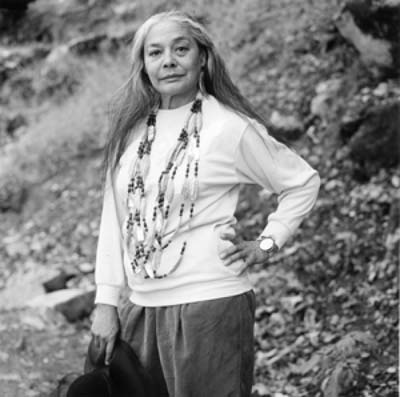
After weeks of negotiations with Santa Cruz and Native American
elders, including an Ohlone descendant from San Benito County, the
developers of a 32-unit housing complex on the Eastside agreed
Monday not to build over an Ohlone burial site.
J.M. Brown
After weeks of negotiations with Santa Cruz and Native American elders, including an Ohlone descendant from San Benito County, the developers of a 32-unit housing complex on the Eastside agreed Monday not to build over an Ohlone burial site.
KB Home will set aside a premier, 13,000-square-foot parcel at the top of a knoll, where several remains were discovered this summer, to preserve in perpetuity for Ohlone elders to gain access for ceremonies. Elders, who believe the spirits of buried people wander if their resting place is disturbed, will be able to use the site in coordination with the homeowners association.
“I am ecstatic,” said Ann-Marie Sayers, a state-designated Ohlone descendant who negotiated with the city and company to preserve the knoll. “Just the fact that KB Home honored the request of the original people whose land they are building on, it is so long overdue for developers to honor sacred sites. I truly believe they did the right thing.”
Sayers, who lives in the Indian Canyon Native American community outside Hollister, were set to join Ohlone elders from other parts of the state in walking the site with company representatives this week. The elders, who had recommended KB Home fully set aside the parcel containing the knoll, will finalize details of the accord reached after numerous meetings since early August, when the remains of an Ohlone child were discovered.
During an archaeological evaluation triggered by the discovery, researchers later recovered remains believed to be teeth and a skull fragment unrelated to the child or each other, officials said. Forensic dogs identified another area on the knoll believed to contain remains, but all sides agreed not to disturb it.
KB Home will establish a permanent cultural easement on land that would have contained a 2,200-square-foot house and driveway, a unit that would have been among the largest and most expensive planned for the community at Market Street and Isbel Drive. The preserved area, where all remains will be buried again, is attached to three acres already set aside to preserve the endangered spineflower.
“We essentially decided to do this out of respect for the elders and folks from the Native American community,” said Ray Panek, senior vice president for forward planning at KB Home, who took part in the talks. “It will be just allowed to go to a more natural state. It seems like a good solution.”
Panek said he did not have immediate estimates on lost revenue for setting aside the land or the total cost to the company for archaeological research. The company agreed to bring in subsurface sonar equipment and forensic dogs at the request of Native American representatives, and two sets of archaeologists worked on the site.
The city ordered the company to stop construction work around the knoll after the remains were recovered. Panek said he expected work would resume soon after the elders walk the preservation area.
“KB was generous in what they were willing to do and elders were flexible in understanding what was possible and meaningful,” said Vice Mayor Don Lane, who participated in the talks.
Lane said the outcome was “a really nice conclusion,” especially amid all of the demonstrations at the site and at City Hall since the first remains were found. “Everyone was a little pessimistic that goodwill wouldn’t manifest.”
For the past month, demonstrators have been calling for an end to building plans around the knoll. Protesters resumed their demonstrating Monday until they heard from officials outside City Hall that an agreement had been reached.









